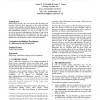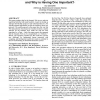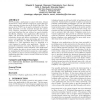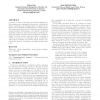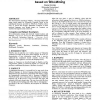HT
2007
ACM
14 years 3 months ago
2007
ACM
We present a method for effective navigation in structure of large information spaces. The method employs incremental browsing of the information space structure and visualizes in...
HT
2007
ACM
14 years 3 months ago
2007
ACM
Folksonomies provide a free source of keywords describing web resources; however, these keywords are free form and their semantics spans multiple contextual dimension. In this pap...
HT
2007
ACM
14 years 3 months ago
2007
ACM
Authorship entails the constrained selection or generation of media and the organization and layout of that media in a larger structure. But authorship is more than just selection...
HT
2007
ACM
14 years 3 months ago
2007
ACM
This paper postulates that for the Semantic Web to grow and gain input from fields that will surely benefit it, it needs to develop an analogue that will help people not only unde...
HT
2007
ACM
14 years 3 months ago
2007
ACM
There is a lack of tools for exploring large non-textual collections. One challenge is the manual effort required to add metadata to these collections. In this paper, we propose a...
HT
2007
ACM
14 years 3 months ago
2007
ACM
HTTP provides a mechanism to connect web sites. Almost all sites have a large amount of hypertext content that provides connection to other sites in the World Wide Web. The succes...
WIKIS
2010
ACM
14 years 3 months ago
2010
ACM
A feature of online communities and notably Wikipedia is the increasing use of managerial techniques to coordinate the efforts of volunteers. In this short paper, we explore the ...
WIKIS
2010
ACM
14 years 3 months ago
2010
ACM
This demonstration introduces WikiPics, a language-independent image search engine for Wikimedia Commons. Based on the multilingual thesaurus provided by WikiWord, WikiPics allows...
WIKIS
2010
ACM
14 years 3 months ago
2010
ACM
While text versioning was definitely a part of the original hypertext concept [21, 36, 44], it is rarely considered in this context today. Still, we know that revision control un...
ECOWS
2009
Springer
14 years 3 months ago
2009
Springer
The Windows Workflow Foundation (WF) has been introduced as part of the .NET framework as a means of creating workflow-centric applications. Its intended field of application is br...

